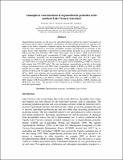Atmospheric concentrations of organochlorine pesticides in the northern Lake Victoria watershed
Author
Date
2006Type
Articleviews
downloads
Metadata
Show full item recordxmlui.dri2xhtml.METS-1.0.item-citation
Atmospheric concentrations of organochlorine pesticides in the northern Lake Victoria watershed
Abstract/
Organochlorine pesticides are still in use for agricultural purposes and for the control of mosquitoes in the Eastern African region. Atmospheric concentrations of organochlorine pesticides are expected to be higher in the tropics compared to temperate regions due to prevailing high temperatures. However, no study has been conducted to investigate atmospheric transport and deposition of pesticides in this region. In this study atmospheric concentration of organochlorine pesticides in air were determined at Kakira near Jinja from November 1999 to-date. Their ranges were as follows: DDT (total) 64.8-610.9 pg/m3, dieldrin 23.6-90.8 pg/m3, a-endosulfan 32.5-206.1 pg/m3, lindane (g-HCH) 20.3-183.6 pg/m3 while chlordane, heptachlor and hexachlorobenzene (HCB) ranged from <0.1-10.1 pg/m3. The insecticide p,p’-DDT was the predominating DDT isomer ranging from 22.6-390.1 pg/m3. However, o,p’-DDT isomer was frequently detected (11.2-62.8 pg/m3) and its metabolite p,p’-DDE was relatively high ranging from 29.9-109.9 pg/m3. The most predominate organochlorine pesticides in decreasing average concentration levels were DDT (total), a-endosulfan, lindane (g-HCH), p,p’-DDT, p,p’-DDE, dieldrin and o,p’-DDT. Average levels of p,p’-DDT and p,p’-DDE at Kakira were lower than those reported for Brazzaville but higher than those reported for Lake Baikal and Southern Ontario while a- HCH, g-HCH, total chlordane and hexachlorobenzene (HCB) concentrations for Kakira were lower than those reported for Brazaville, Lake Baikal, Southern Ontaria, Arctic and Antarctic. In comparison with data from Senga Bay, Lake Malawi in Malawi, average DDT (total), p,p’-DDE, p,p’-DDT, o,p’- DDT, lindane (g-HCH) and SHCH levels were higher whereas average dieldrin, a-HCH, chlordane and HCB levels were lower. The presence of these chemicals in air at Kakira is most likely due to both local and regional inputs

